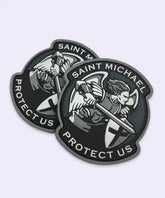Patch It, Don't Ditch It! Your Complete Guide to Custom Iron-On. Patches 2025 updated
Table of Contents
- What Are Custom Iron On Patches?
- A Comprehensive Guide to Types of Custom Iron-On Patches
- The most popular and common ones, we will discuss further
- 1. Embroidered Patches
- Why people love them:
- Limitations:
- 2. Woven Patches
- Why they stand out:
- Drawbacks:
- 3. Printed Patches
- Why they’re popular:
- Downsides:
- 4. Chenille Patches
- Why they’re unique:
- Considerations:
- 5. Name Patches
- Why they’re useful:
- 6. Appliqué Patches
- What makes them appealing:
- Drawbacks:
- 7. Bullion Patches
- Why they’re special:
- Things to know:
- Not Every patch is Ironable
- How to Iron a patch in a step by step tutorial
- What You’ll Need
- The Process
- Additional Advice and Misconceptions to prevent
- 5. What is the Reason to use Custom Iron-On Patches in your next Project?
- Branding and Identity
- Fashion and Individuality
- Cost-Effectiveness
- Ease of Use
- Conclusion
- FAQs
- Q: Can I take off an iron on patch in the case of a mistake?
- Q: Which materials should be used in iron-on clothes patches?
- Q: What is the best way to wash and take care of apparel that has custom iron-on patches?
- Q: Are iron-on patches durable?
- Q: Could I place a customer order of iron on patches?
What Are Custom Iron On Patches?

Did you ever find a drab jacket, hat or backpack and thought that something personal was needed? Or you would have liked to sew a small hole on your favorite jeans in a pretty, stylish way? If so, you've come to the right place. Custom Iron on Patches are your secret weapon for easy and creative customization. But What Are Custom Iron On Patches? To put it very simply, they are specialized symbols that are filled back with special heat-activated glue. Instead of performing the procedure of sewing them on a needle and thread, you can bind them permanently on the fabric with a simple family iron and ironing a patch on any individual can create a fast and easy craft activity. These patches do not simply sew up torn garments. They provide an effective way of self expression. You can get your band a name, you can sponsor your sports team, you can get your little business a name, whether you like it. business, personalized iron on patches offer a unique canvas. They can be created using any text or image that you can think of, and with any logo. The best part? Applying these custom fabric patches doesn't require any sewing skills, so you won’t poke holes in your delicate garments. This makes them perfect when it comes to providing a unifying look to a group, adding a touch of glitziness to fashion items, or merely having your characters be seen in your fashions.
No-Sew Solution: Iron on cloth patches are easy to use and this is the highest advantage of using it. You can achieve professional-like results without using a needle.
Infinite Personalization: You can make tributes to your company logo to a dumb inside joke with your friends a design of your own.
Powerful and Durable: The connection is solid and can resist the usual wear in case of proper implementation and washing.
Multipurpose Applications: They do not have merely textile applications. Bling bags, hats, shoes and even home decor items like pillows.
A Comprehensive Guide to Types of Custom Iron-On Patches
On the case of Custom Iron-On Patches, you are bound to have numerous styles to select. Each has its own look, texture, and purpose. Some are more appropriated to logos and others to detail. artwork or bold letters. They are also quick and easy to apply on using an iron-on backing, though. remember--patch type may not take the heat.
The most popular and common ones, we will discuss further

1. Embroidered Patches
The classic one is embroidered patch and deservedly so. They’re made by stitching embroidered onto a firm fabric base of coloured cloth, usually twill. This creates relief, pitted finish whichis apparent in jackets, uniforms and hats.
Why people love them:
- They are sustainable and they outlive the passage of time.
- They seem bold especially where there are logos or unadorned pictures.
- Their style is an old patch look that is timeless.
Limitations:
- Its stitches are thick and thus the letters are thin.
- Very complex photographic images or gradients will not present herself well.
- Sports teams (or any other badges), military badges, company logos and fashion denim jackets are best applications.
2. Woven Patches

Strips of the woven work are made in different manners. The slender fibers are sewed on a foundation instead of interwoven to create the pattern. The result is sharp, straight and smooth.
Why they stand out:
- They can scan fine line and small text.
- They are not so heavy and coarse like embroidered patches.
- Lines are crisp, contours are smooth.
Drawbacks:
- They do not have the more peripheral patterned touch of embroidery.
- They will be flatter in case you would wish a bold, heavy composition.
- Best uses: uniforms, fashion brands, scout badges and brand labels where detail is a problem.
3. Printed Patches

The design is printed on the printed patches by using dye-sublimation or screen printing patch fabric. The one that is in full color art or photograph.
Why they’re popular:
- They can support gradients, shadows and photographic like detail.
- They are appropriate with complex logos with many colors.
- They are also less expensive in their exuberant designs.
Downsides:
- They are not textured in any way and hence can be more of a print than stitch.
- They are also able to be burnt off under the sun.
- The best contents are fashion, creative work, brand merchandise and promotion design.
4. Chenille Patches

The areas of chenille are fuzzy. They are produced with looped yarns which pull out of the cloth so that it looks stout and spongy, you are thinking of varsity jackets thinking of chenille.
Why they’re unique:
- Their effect is bold, retro and 3D.
- They are lovely and pleasant to touch.
- They are sporty, old-fashioned-looking.
Considerations:
- Small details will not be apparent.
- These are the heaviest of all the patch styles.
- Best uses: school spirit wear, varsity jackets, plain letters and huge forms.
5. Name Patches

Sometimes, simplicity is the key. Name patches merely do that, display the name or title of an individual. They can be embroidered or woven, more or less worked up.
Why they’re useful:
- They are inexpensive and shall be customized.
- They turn uniforms to professional ones.
- They show unmistakable identification of workers, students or team members.
- Excellent applications: work uniforms, mechanic shirts, medical staff badges or event team badges.
6. Appliqué Patches

Appliqué patches are patches that consist of bits of fabrics that have been sewn over a backing fabric to form a pattern. Think of it as layered fabric art. It is more artistic and decorative than printed or embroidered patches.
What makes them appealing:
- They add depth, dimension.
- They have an artisan look.
- They can mix the different fabrics and textures in order to be creative.
Drawbacks:
- They also take longer to produce.
- Their fashion is superior to rough everydayness.
- Best applications denim jackets in women, hottest projects, accessories of costumes, and unique streetwear.
7. Bullion Patches

Bullion patches are opulent and fancy. Drawn by hand with metallic wires, beads or silk threads. This provides a three dimensional effect that sparkles with light.
Why they’re special:
- They appear lavish and fancy.
- Their application is often linked with rewards, organizations or top schools.
- They can even be kept on years provided that they are taken good care of.
Things to know:
- They are bulky and they do not fit into the casual wear.
- These are the most expensive types of patches.
- Best uses military badges, school crests, high end fashion and ceremonial uniforms.
Not Every patch is Ironable
These types of patches can be either iron-on-backed with most, or non-iron-on backed. PVC patches (flexible rubber) can melt in the heat. Patches of leather may scald or be distorted when ironed. In the case of them, the method that is safer and to be suggested is sewing. It ensures the patch remains attached without spoiling the material.
How to Iron a patch in a step by step tutorial
Learning to iron on a patch is not complicated but it requires time. Once you learn the basics, the bond may be in years. Consider it as putting two cloths into one narrative.
What You’ll Need
Preparation Before you begin, take your tools. Any ordinary household iron will do. A thin cloth, like a tea towel, or pillowcase, to cover the design. A solid heat-resistant surface like an ironing board or wooden table. And of course your garment and patch. It is a good thing to have it all around and stress-free.
The Process
- Preparation - Turn on your iron. Adjust it to medium-high, and no steam. Steam weakens the adhesive, so keep it dry.
-
Prepare - Flatten the garment on a flat surface. Stick the patch anywhere you desire.
It goes to remind you that when bonded, then it is not easy to move. - Protect -Cover the patch with your thin cloth. This is a barrier that shields the threads and colors against direct heat. Embroidery is liable to burn or fail without it.
- Apply Heat - At this point, wipe down with the iron and press the iron on the fabric using a hand in 30-45 seconds. Don’t slide the iron around, as that can shift the patch. Steady pressure works best.
-
seal the Bond - Turn the clothing inside out. Heat rear of patch area one more time 20-30.
seconds. This makes sure that the glue penetrates the material. -
Cool Down - Last, allow everything to cool down. Premature handling may loosen up the seal. Wait at At least 24 hours before washing to give maximum hold.
Additional Advice and Misconceptions to prevent
- Always check the fabric type. There are also sensitive clothes that are not able to withstand direct heat.
- Don’t rush the cool-down step. The glue can be softened by heat, but firmed by cooling.
- Should the edges be elevated subsequently, use some additional heat within a few seconds using the cloth barrier.
- Your own iron on patches of clothing will not simply stick when done correctly. They’ll feel like part of the garment itself. Pretty satisfying, right?
5. What is the Reason to use Custom Iron-On Patches in your next Project?
Of all the patch options available, why then do you want to use custom iron-on patches? The reasons are both practical and creative. They suit nearly every requirement, whether it is fashion or business and make things fun and affordable.
Branding and Identity
Patches are potent when they belong to a company, sports team or club. On a personalized fabric patch a logo is immediately recognized. Think about having jackets with the same design on your entire team. It builds cohesiveness, and it does not appear to have cost an enormous amount of money to look professional.
Fashion and Individuality
And now we are going to talk about personal style. General apparel is so generic, eh? But a single patch changes everything. Perhaps it is your initials on a cap, a band badge on your back pack or an old time badge on your denim jacket. These customizable iron-on badges allow you to put on what you are. They’re fashion lines but they are also little bits of your story.
Cost-Effectiveness
Something you’ll like about these is that they are affordable. Tailored clothing is relatively expensive, particularly when you are ordering for a group. When you use iron-on patches, you just end up paying the patch. It will fit on a cheap shirt, hat, or bag, and then you have a one-of-a-kind. You have the appearance of the custom at less than the cost of the custom.
Ease of Use
And last, the cherish best. Sewing takes skill and time. It only takes minutes to iron on a patch. Heat, press, and done. You can do this even when you have never made anything in your life. It is perfect because the process is quick in hurry, school uniforms, or just brightening up on of the old stuff.
Conclusion
Iron-on patches are custom made to combine style, functionality, and creativity. They come in many types, each with its own strengths. Starting with embroidered to woven, printed to chenille, you are sure to find the right one your project. And it is simple heat, press, and wait to apply them. No needles, no stress.
Considering that there are a number of old jackets, bags, or jeans in your closet that you just forgot about? With just a few patches, they can feel brand new again. It is the magic there is no patch that is not fabric, it is refreshment, reconstruct, or create something of your own.
So here’s the takeaway. One patch will make the boring clothes a personal statement. It’s fast, affordable, and fun. It is only left to ask, what will be the next patch to your story?
FAQs
Q: Can I take off an iron on patch in the case of a mistake?
A: Yes, but it takes care. Warm back the patch with an iron and remove it when it is warm. Any leftover glue may be frequently washed with remover of adhesives.
Q: Which materials should be used in iron-on clothes patches?
A: Cotton, denim and canvas are the best. Do not use nylon or polyester as it may melt. For delicate materials, fabric glue can also be safer.
Q: What is the best way to wash and take care of apparel that has custom iron-on patches?
A: Wash clothes inside out. Wash in cold water but gently. Skip bleach and softeners.
Preferably dry it by air, however a low-heat dryer is also suitable.
Q: Are iron-on patches durable?
A: Yes, applied in the correct way they do well. To add additional strength to frequently used things, sew around, the edges after ironing.
Q: Could I place a customer order of iron on patches?
A: You can find them in a number of online stores such as Vivi pins, Patches4Less, and Ninja Patches. Most provide no-minimal orders and numerous supporting options.







